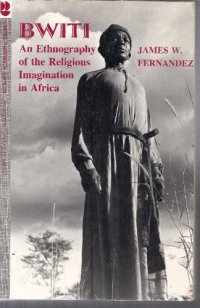
Ebook: Bwiti: An Ethnography of the Religious Imagination in Africa
Author: James W. Fernandez
Bwiti maybe describedas a syncretistreligionderivedfroma varietyof autochthonous and Christiantraditions.One of its areasof occurrenceis the northernand northwestern part of Gabon, where it is particularlyassociatedwith the Fang, although it is or was neveradheredto by morethan8 or 10 per cent of the Fangpopulation(p. 356). Its members claim that their imaginativeelaborationsof liturgy and belief come to them in dream communicationswith the ancestorsor under the influence of eboga,a drug to which they are deeply attached(p. 4). As a matterof fact, Bwiti is one of the few Africanreligious movements to argue its potency from the constant use of a psychoreactivedrug rather than,say,possessionbysupernaturableingsortheimpersonationofsuchbeingsbymeans of masks.It is at the sametime also a highly polymorphousreligion,exhibitingsubstantial variationsin doctrine,worshipandsymbolismfromonebranchto another,depending among other things on the degree to which affinity with Christianityis emphasisedor de-emphasised.Fernandez'sstudy limits itself to the branch known as AsumejeEning ('Commencementof Life') which, though said to lean more towardsthe autochthonous religiouspole, has neverthelessadoptedcertainbiblicalfigures,includingEyenZame(Jesus Christ) and NyingwanMebege(the Virgin Mary), as 'Great Gods'.
In addition to a number of local ethnographersBwiti has over the past thirty to forty yearsalso attracteda small crowd of internationalsocial scientists, which by now makes it one of the most extensively and profoundly described African religions. Apart from Fernandezone could mention the names of Viciana Vilaldach(for equatorialGuinea),
GeorgesBalandier,Rene Bureau(not mentionedby Fernandez),StanislawSwiderskiand, more recently, Andre Mary (La naissancea l'envers:Paris: l'Harmattan, 1983). Since Fernandez'sfield researchended in 1960, his study should be consideredas pertaining to the conditionsprevailingin or up to the late 1950s.For informationon laterdevelopments one has thereforeto turn to authorssuch as Mary.
Before the publicationof this magisterialstudy Fernandezhad already,over a period oftwodecades,exploreditsmainthemesinanimpressivenumberofarticles,which,taken together, give us a good idea of the way his thinking on Bwiti has developed. As anthropologistsare becoming more and more awareof the need to study the influences,
pressuresand processesunderlyingtheir own production,and as Fernandezhas by now become a leading figure in Africanist anthropology,it may be worthwhile one day to reconstruct his intellectual journey, much like J. L. Lowes (Fernandez's model) reconstructedthe genesisof Coleridge's'KublaKhan'.One area,amongseveral,in which such a study might be fruitfully undertaken is Fernandez's presentation of Bwiti christologicalthinkingat differentstagesof his career,a subjectwe will returnto later in this review.
In addition to a number of local ethnographersBwiti has over the past thirty to forty yearsalso attracteda small crowd of internationalsocial scientists, which by now makes it one of the most extensively and profoundly described African religions. Apart from Fernandezone could mention the names of Viciana Vilaldach(for equatorialGuinea),
GeorgesBalandier,Rene Bureau(not mentionedby Fernandez),StanislawSwiderskiand, more recently, Andre Mary (La naissancea l'envers:Paris: l'Harmattan, 1983). Since Fernandez'sfield researchended in 1960, his study should be consideredas pertaining to the conditionsprevailingin or up to the late 1950s.For informationon laterdevelopments one has thereforeto turn to authorssuch as Mary.
Before the publicationof this magisterialstudy Fernandezhad already,over a period oftwodecades,exploreditsmainthemesinanimpressivenumberofarticles,which,taken together, give us a good idea of the way his thinking on Bwiti has developed. As anthropologistsare becoming more and more awareof the need to study the influences,
pressuresand processesunderlyingtheir own production,and as Fernandezhas by now become a leading figure in Africanist anthropology,it may be worthwhile one day to reconstruct his intellectual journey, much like J. L. Lowes (Fernandez's model) reconstructedthe genesisof Coleridge's'KublaKhan'.One area,amongseveral,in which such a study might be fruitfully undertaken is Fernandez's presentation of Bwiti christologicalthinkingat differentstagesof his career,a subjectwe will returnto later in this review.
Download the book Bwiti: An Ethnography of the Religious Imagination in Africa for free or read online
Continue reading on any device:

Last viewed books
Related books
{related-news}
Comments (0)